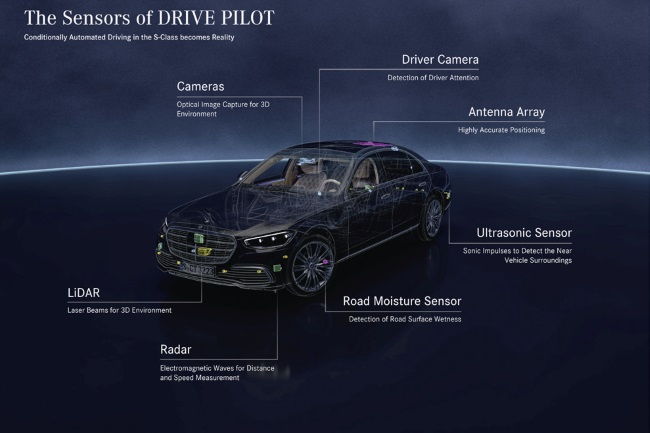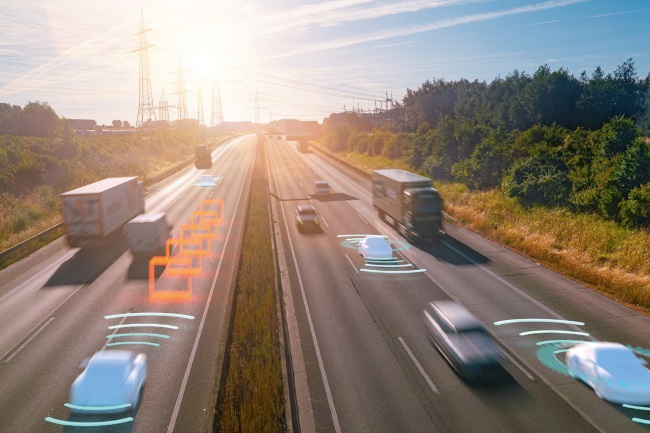In our latest Motoring news article auto expert Dimitri Urbain looks to see what the future holds for fully autonomous vehicles.
Gerry Anderson fans rejoice: Lady Penelope’s FAB 1 Rolls Royce is getting closer to reality as so-called ‘autonomous’ cars will soon communicate with each other and with traffic lights or satellites. However, these autonomous cars will not be possible without 5G, the latest generation of wireless communication.
Back in 2014, The Society of Automotive Engineers (SAE) established five autonomy levels for cars. Autonomous vehicles are not available yet, but many autonomous technologies are now standard on a wide range of new cars.
Autonomy levels 1-5
The first level is the most basic: there is no real “autonomy” here – the driver is in charge of the driving all the time. However, there is some “assistance” to help him/her. Level one first appeared in the late 1990s when Mercedes launched its radar-controlled cruise control. One part of the driving is monitored on its own by a whole range of sensors and cameras, like a radar-monitored cruise control. In 2008, Honda introduced a lane-keeping system on the then new ‘Legend’ car.
Level 2 or partial driving automation has been around since about 2010. Computers monitor various functions rather than allowing the driver to do things his or her way. In other words, ADAS (Advanced Driver Assistance Systems) is not witchcraft, just various data sources providing loads of information. As there is now enough processing power, it is possible to monitor both speed and steering at the same time, for example. Level 2 also includes self-parking, lane-keeping or driver-tiredness monitoring systems. All of these can now work reliably and efficiently.
Advanced cruise control systems use sat-nav (satellite navigation) data to brake automatically ahead of corners. In congested areas, the same system will maintain a safe distance from the car in front and set itself off when the traffic gets lighter, without any driver input. Most current Audis, BMWs, Mercedes, Lexus, Teslas and Volvos have these systems as standard features.
Level 3 is “conditional automation”: the driver must be alert at all times, but the car can take the lead and drive on its own, in control of all safety-related functions. Here, algorithms process data from maps, radars and sensors more quickly. Drivers can even have their hands off the wheel from time to time. Top-of-the-range cars, especially some electric-powered ones, allow this level of control. Both Honda and Mercedes introduced certified Level 3 cars in 2021. The new Honda Legend is currently only available in Japan with its traffic jam pilot system. The 2022 Mercedes S Class and EQS electric cars feature a new advanced Drive Pilot system.
Level 4 is estimated to become a technical reality by 2025. It relates to “fully autonomous driverless cars in controlled areas”. According to Uta Klawitter, head of Audi’s legal counsel, it could become legal by 2030. With this level, car-to-car live data sharing and car-to-car communication are compulsory. Although actual drivers would not be needed at this level, a call centre would always be on hand to make sure everything works efficiently. Level 4 autonomy availability will depend largely on the 5G network coverage. Elon Musk recently said Tesla should achieve Level 4 autonomy by the end of the year.

Finally, the SAE defines Level 5 as the “fully autonomous driverless car”. Neither steering wheel, nor driver are needed, just jump in and let yourself be taken to where you need or want to go. Data volume and processing speed will be even more crucial here.
For Dr Michael Hafner, head of Automated Driving and Active Safety at Mercedes, Level 5 autonomy is unlikely to become a reality before 2035. There would be enough time for car manufacturers to ensure autonomous cars withstand any cyber-attacks and, with authorities, to deal with liability issues. In a car accident will the autonomous carmaker or driver be liable? Or if two drunk pedestrians are behaving carelessly in the road, which one will the automobile “choose” to hit? For now, there is no suitable answer.
With that in mind, carmakers and European authorities remain cautious about fully autonomous cars: “Technological progress alone will not be sufficient for Connected and Automated Vehicles (CAVs) to achieve their potential,” said the European Commissioner for Innovation, Research, Culture, Education and Youth Mariya Gabriel, following publication of a September 2020 report containing 20 recommendations for a safe and ethical transition towards driverless mobility: “The timely and systematic integration of ethical principles will be essential to align this emerging technology with our societal values and needs.”
The 5G challenge
5G, as stated, is essential for CAVs. 5G communication will enhance our smartphones’ speed and reliability, resorting to under-used radio waves. Current 4G systems can deliver up to 1 Gbps of data per second on a 20 MGhz bandwidth. But so many smartphones and other devices use it that it is running at full capacity, meaning smartphones lose connection in crowded areas.
5G can go up to 100 MGhz bandwidth and transmit up to 20 Gbps, on average. It will provide a strong and uninterrupted signal while drastically reducing the time to get a response when the information has been sent. The larger bandwidth will allow the connection of up to one million devices per square kilometre. Artificial intelligence combined with low latency (reaction time) will make this possible.
That is why 5G is so attractive for myriad future applications, from human health issues monitoring to lean industrial production or domotics. More devices – including cars – can be connected and work together at a higher speed. This technology will improve the way autonomous cars behave and connect almost every aspect of our life. The only limits to new 5G applications will be our imagination and the setting up costs.
5G in Belgium
It is not all roses with 5G, however. In Belgium, the Stop 5G group, combining 23 organisations and non-profit making bodies, wants to delay 5G implementation in Belgium, saying it could harm humans and animals. In any event, 5G only covers tiny parts of the country – mainly large urban areas like Antwerp, Brussels, Leuven and Gent. It is primarily used for entertainment purposes as it dramatically slashes films’ download time.
Widespread 5G use will need many transmitters. They could easily be fitted to lamp posts or road signs, as they do not need a lot of power. However, they have to “see” one another and need a line of sight to work effectively. One would be needed every 400 metres of a motorway, and even more on curves. In urban areas, they should be on every street corner as 5G cannot see through buildings.
For now, 5G in cities is possible, but rural areas will be more problematic. A combination of terrestrial stations and satellite receivers should improve the situation.
Notwithstanding 5G limitations, from 2025 onwards, premium cars with 4G and 5G will be mobile entertainment hubs including virtual reality. 3D films will be streamed instantly, while more sensors and increasingly powerful software will play an even bigger part in the driving experience.







